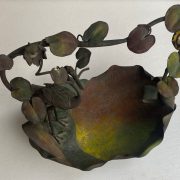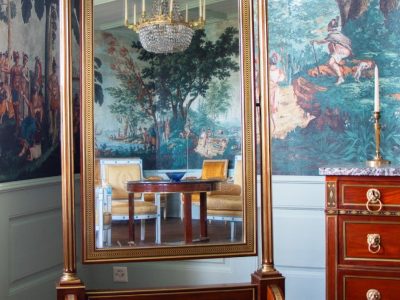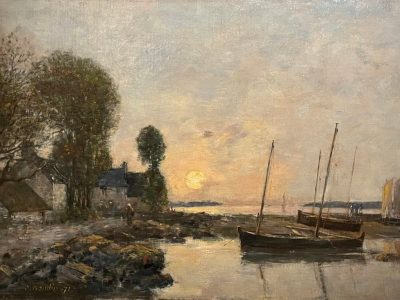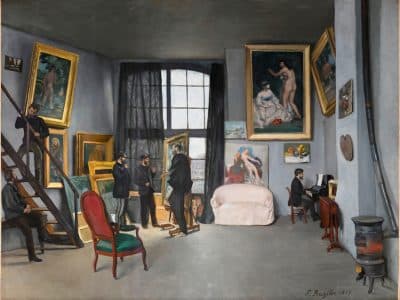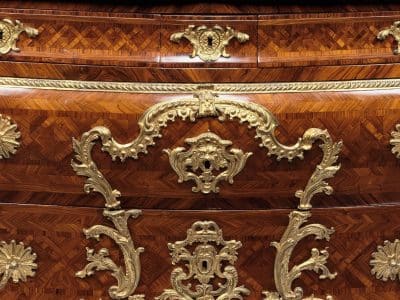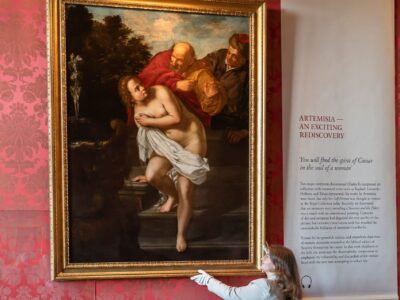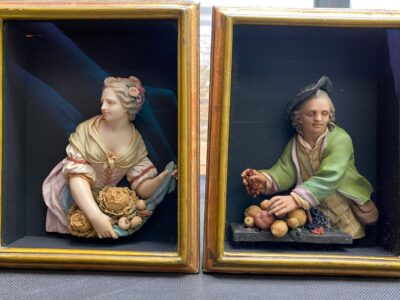In the 17th and 18th centuries, some artisans from the Duchy of Lorraine made their art known in France and were, as well, exporting all over Europe. They were sculptors and carved remarkable objects and artworks in a special wood with red tones, the Saint-Lucie wood (bois de Sainte Lucie in French). Or you may have heard of their production under a different name, Bagard wood. It comes from the artist’s name César Bagard (1620-1707), indeed an outstanding sculptor of large statues.
With this article, we intend to help you discover the items made in Saint-Lucie wood by giving you context about Lorraine and when they were made. As well as give to César’s the things that are César’s… and to the other artists what is theirs. You will understand why sticking to the term “Saint-Lucie wood” makes much more sense than “Bagard wood”.

17th-century heraldic putto in Saint-Lucie wood. © Spinario
Where Sainte Lucie Met Prunus Mahaleb

Sainte Lucie of Syracuse is not the Lucie of our story. 16th-century French polychrome wood statue. © Autour de 1500 Antiquités
To get us started, let us try to understand what Sainte Lucie has to do with this wood. This is not about the most famous Sainte Lucie, Lucie of Syracuse, a martyr of the 4th century usually represented with her eyes on a plate. The story goes that this Lucie wanted to stay a virgin and devote her life to God. Her fiancé refused this idea and claimed that he loved her for her beautiful eyes. Hoping it would solve her problem, she pulled out her own eyes and brought them to him.
Our Lucie who landed in Lorraine shares the same faith and resolution, but she has a very different story. She is a 9th-century princess from Scotland. Or maybe she lived in the 8th century, which says a lot about how much we know about her. Apparently, she got tired of her father’s perverted court and decided to live a more saintly life. Her travels led her to the small village of Sampigny where she worked as a shepherd–yes, legends and history are often difficult to set apart–and lived like a hermit. At night, she was spinning wool in a cave on a hill by the light of a lamp, the oil of which was miraculously healing sick people. After she passed away, miracles continued, this time produced by the oil of her grave’s lamp. On top of this, from her distaff planted in the soil miraculously grew a new kind of cherry tree, prunus mahaleb (aka mahaleb cherry or St. Lucie cherry), and then a whole forest filled with this wood.

A 16th-century tomb effigy of Sainte Lucie of Scotland was in the church of the Sampigny Minimes convent until the French Revolution. Many engraved dated graffiti of the 17th and 18th centuries were made by the pilgrims. Now in the Musée d’Art Sacré de Saint-Mihiel © Frédéric Madiai/ France Télévisions
With all these miracles happening, you can imagine it became a pilgrimage site. A church, Sainte-Lucie-du-Mont, was built to keep her relics. Far later on in 1625, a monastery held by the Order of Minims was funded. Somehow, sterile women would become fertile after praying Sainte-Lucie there. The Queen Anne d’Autriche, wife of King Louis XIII, had suffered many miscarriages. She would have stopped there in 1632 or 1633 to ask for an heir, and tada, in 1638 Louis-Dieudonné, who would become Louis XIV, was born. For the least, this anecdote shows how renowned the Sainte-Lucie pilgrimage was.

Anne d’Autriche with her son Louis XIV, approximately one year old. Oil on canvas by Atelier Beaubrun, c. 1639-1650. In Château de Versailles.
Unfortunately, the mahaleb cherry trees can no longer be found today in Sampigny and Lorraine. Could it be because of its many usages in carving? We will go into these further down. The good news is that however nice is the Sainte-Lucie story to explain the appearance of this species, in reality, this essence is native to central Asia, the Mediterranean region and going further north in Europe and still present today in may areas. Maybe you enjoyed mahlep in your food before? The ground seeds of mahaleb have been used in breads and pastries in Greece, Turkey, and Egypt.
Sampigny: Near Nancy, Capital of the Duchy of Lorraine
It is likely you are not familiar with Sampigny. The Meuse river goes through this small village. It sits in the Lorraine region about 60 kilometers northwest from Nancy.

Lorraine under growing French pressure in the 17th century. We selected this map despite being in French because it illustrates very clearly how the French (in all the pink/red colors) are progressively nibbling away and surrounding the Lorraine territories. (From “(Dé)construire un Etat dans un territoire d’entre-deux. Le Piémont-Savoie et la Lorraine à l’époque moderne”, paper by Alexandre Ruelle)
Lorraine was a complex and fragmented territory, politically and culturally, land on the border of two strong nations. Because it emerges from medieval Lotharingia, the Duke of Lorraine is historically connected to the Holy Roman Empire. While being officially freed from the Empire since the Treaty of Nuremberg of 1542, the Duke of Lorraine still has a voice at the Imperial Diet thanks to his Nomeny lands. France on its West flank is an ambitious neighbor, and staying independent is a arduous job. The Thirty Years War from 1618 to 1648 was a terrible demographic and economic blow to Lorraine. Under Louis XIII and Louis XIV, France occupied parts of Lorraine repeatedly. From 1633 to 1697, Nancy was mostly in the hands of the French. After the Treaty of Ryswick in 1697, the Duke of Lorraine was back, opening a new era of prosperity that continued after 1737 when the duchy became officially French.
Being at the crossroads of these different cultural zones enabled Lorraine to have artistic stimulation from the Flanders, Burgundy, German lands, France and Italy. In the 16th century, before Sainte-Lucie wood acquired its popularity, Lorraine birthed three important sculptors. The biggest of them, Ligier Richier (c. 1500-1567), lived in Saint-Mihiel only 10 kilometers away from Sampigny. He mastered stone and wood. The second one, Mansuy Gauvain (fl. 1505-1542), worked mostly in Nancy. Jean Crocq (fl. 1480-1510) was originally from Bar-le-Duc (30 kilometers West of Sampigny) and had a workshop there. These three sculptors had talents for complex and expressive compositions, bringing life to clothing thanks to voluminous drapery and lavish ornemental details.

Swoon of the Virgin in Saint-John’s arms by Ligier Richier. Made in polychrome walnut before 1532. © Saint-Michel abbey church in Saint-Mihiel
Religious Artifacts and Carvings in Saint-Lucie Wood
Getting back to Sainte-Lucie wood, with the pilgrimage attracting many people in Sampigny, the miraculous wood was put at use. Over the 17th century, the creation of devotional objects or sacred art carved in this wood grew. It would include rosaries, crucifix, low reliefs, statues of the Virgin Mary, Saints or Christ.

Low reliefs of Christ and the Virgin Mary, Louis-XIV period. © Antiquités Expertise Guillaume Rullier
A crucifix is a classic item in Saint-Lucie wood. A common version is of a fairly large size with a Christ approximately 40 cm high and 30 cm wide. There is a subtle contrast between the red warm highlights of prunus mahaleb against an overall dark chocolate tonality.

Framed crucifix in Saint Lucie wood. © Pierre Brost
There seems to be a conventional representation of the Christ as a Christus patiens, a suffering Christ looking towards the skies with his eyes and mouth open in the perfect posture to be saying “My God, My God, why have you forsaken me?” before he expires. The two feet are resting on the supedaneum, each foot is nailed. A total of four nails was rather uncommon for a crucifixion after the Renaissance.
These crucifixes recall the Christ on the Cross by Francisco de Zurbarán (1598-1664) made around 1635. This artwork abides by the the aesthetic canon developed after the Council of Trent to strenghten the reaction against protestantism. Counter Reformation induced the development of many monasteries in Lorraine in the 17th century. Images need to emulate spirituality. On a dark background, the Christ gets all our attention and compassion.

Christ on the Cross by Francisco de Zurbarán. Oil on canvas, c. 1635-40. © Sotheby’s
Even more pathos can be found in the carved crucifixes thanks to a traditional contrapposto, the twisting of the body enhancing the suffering of Christ. With a typical barocco maestria, a sophisticatedly-draped perizonium adds movement to the scene.

Crucifix Saint Lucie wood around 1700. © La Sculpture Francoise
Beautiful Treens Ornated Like Silver
These are objects with practical purposes that gave an international fame to this wood. The first writing mentioning objects in Sainte-Lucie wood was published in 1751 in the “Bibliothèque Lorraine” (meaning Lorraine Library) written by a Benedictine monk Dom Augustin Calmet (1672-1757): “Many small works in Sainte-Lucie wood are made in Lorraine, which we send to foreign countries. And that keeps several workers busy.”

Candlestick in Sainte Lucie wood. © Galerie Pellat de Villedon
Ironically, this is because of wars opposing France and the Holy Roman Empire, i.e. putting Lorraine right in the middle, that Sainte-Lucie wood took a unique trajectory. To support endless onerous military campaigns, Louis XIV introduced sumptuary laws in 1689 and 1709. His subjects had to dispose of objects in precious metals so that they could be melt down to finance the wars. And consequently, these objects had to be replaced. The trade for these items was active until the late 18th century.

Small mirror in Saint-Lucie wood. © Arnaud de Spa
Because Saint-Lucie wood is so dense and fine grained, carvings can be very precise. Such treens ornated with foliages, flowers, fruit baskets, grotesques are clearly reminiscent of silverware. It was also less expensive than ivory. A particular area of specialty was beauty accessories such as brushes, mirror frames, boxes of various shapes (for needles, ribbons or cosmetics, wigs, etc.).

Boxes in Saint-Lucie wood. On the left, a small cosmetic box decorated with a flower basket © Antiquaires David Balzeau & Pascale Brion. On the right, a large box with an escutcheon displaying MRA initials, acanthus leaves, and shells © Antiquités Expertise Guillaume Rullier.
César Bagard (1620-1707): Why Bagard Wood?
As mentionned earlier, many items made in Sainte-Lucie wood have been attributed to César Bagard. Bagard, born and deceased in Nancy, is a major sculptor from Lorraine in the 17th century. Despite the political complexities of his time in Lorraine, he was able to work both for the French or the duke Charles IV on major projects. In 1669, he is officially recognized and licensed by the duke as a sculptor appreciated for his talent and his training “in foreign provinces to see the most excellent craftsmen”.
When it comes to his documented corpus, only twelve of his artworks are conserved today. He essentially made religious sculptures or funerary monuments, mostly in stone and sometimes in wood. We know for sure he carved in wood a Saint Honoré made for a Dominican church and a Nativity for a Carmelite church.

Funerary monument of Jean des Porcelets de Maillane made by César Bagard in 1679-1680. In the Musée Lorrain, Palais des Ducs de Lorraine. © Francois Munier
César had a son born in 1651, Toussaint, who became a sculptor as well. Toussaint Bagard (1651-1712) worked for instance with his father on the façade sculptures made for the Chartreuse of Bosserville. We know for certain that he executed two crucifixes, possibly in wood, commissionned by Nancy and offered to the Maréchale de Lorges in 1695 and the duchesse Élisabeth Charlotte d’Orléans in 1698.

Five statues carved by César Bagard and his son Toussaint in 1692 for the façade of the Chartreuse de Bosserville. © Destination Nancy
Bagard’s talents also left an indirect mark in the European courts as he was a master to Jacob Sigisbert Adam (1670-1747), the first generation in a dynasty of illustrious sculptors.
It is clear that César Bagard was a specialist of large statues, “sculptor of large figures”. Somehow early in the 19th century, many of the Sainte-Lucie wood artworks got erroneously attributed to him, which led to the so-called “Bagard wood” name. Although corrected by specialists as early as 1853, the wrong attribution was out of the bag, living its own life…
And Many Other Artists: Foulon, Lupot, Chassel…
There were many other skilled sculptors in Nancy and Lorraine who were working on Sainte-Lucie wood. At the time, they would have been registered or recognized as “sculptors in small” or “sculptors in wood of Sainte Lucie”. Among them was the Foulon family. As Dom Calmet wrote: “The Foulons were once quite known and did many works for the Dauphin, son of Louis XIV.” Lorraine is a small sculpting world and César Bagard was the godson of César Foulon (hence the same first name).
We need much caution with attributions as the works are rarely signed and proper evidence is scarce. Some artist names stand out. For instance, two of them have been associated with crucifixes more than others: Jean-François Lupot (1684-1749) and Charles Chassel (fl. 1655-1680). Being from Mirecourt, Lupot had the specificity to work also on grotesque heads that the luthiers would use to ornate violins. In other words, he developed a skill for creating expressive faces. According to Dom Calmet again, Charles Chassel was a “very skilled sculptor for small figures, his crucifixes being highly valued.”

Cane pommel carved in the round. © Farella Frank
Quite often, a name is associated with a workshop, involving other craftsmen or family members. Above, we talked about the Foulon dynasty. The same would apply to the Chassel, Manvuisse, Vallier, Mesny or Hardy families with usually one member with a stronger reputation (Nicolas Foulon or Regnault Mesny for instance). Attesting to the success of the Saint-Lucy wood artifacts, Nicolas Foulon (1628-1698) even partnered with Alexandre Mestrejean of the faubourg Saint-Antoine in Paris to set up a workshop in the French capital.

Louis XIV Crushing Heresy by Regnault Mesny (1662-1712). Saint-Lucie wood figure made in 1687. © Sotheby’s
You May Like
Bois de Sainte-Lucie | Crucifixes | Wood Sculptures | Religious Art & Rituals | 17th-18th-Centuries Boxes & Cases | Louis XIII Period Antiques | Louis XIV, Régence Period Antiques


